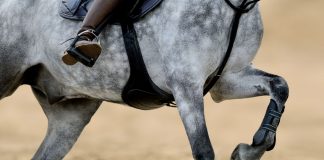
One: You’ll probably notice some squeaky sound effects the first time you cinch it up and climb aboard. Two: The saddle will also be stiff as a board–not quite what you’d expect from an otherwise appealing (and expensive) piece of tack. However, not to worry: We’ve got a couple tips to get that saddle soft and silent.
First, condition the saddle. That will help make the leather more supple and hasten that broken-in feeling. Applying a conditioner replenishes the natural oils that were depleted in the tanning process. The standard treatment is to use pure neatsfoot oil; however, a quality leather emollient specifically designed for new tack will also do the job. When in doubt, consult with the saddle’s manufacturer for the most appropriate product. Focus your conditioning treatment to the underside of the saddle. Otherwise, your jeans will be stained with any excess residue and you might permanently discolor any suede or roughout leather. Also keep in mind that many products will darken leather, which is a big disappointment if you truly want to maintain the look of very light tack. For this reason, always test any product you intend to use in a tiny, discreet area, just so you know how it will affect the leather’s appearance.
Be careful as you work the conditioner into the new leather. Use a paint brush or a clean, soft cloth for application. This will allow you to treat hard-to-reach places like the tip of the fenders.
“Just don’t dip or soak a western saddle in neatsfoot oil,” cautions Anne Fordyce, marketing manager for Circle Y Saddles. “If you over-saturate the leather with oil, it becomes spongy and weakened. The pores of the leather can only absorb so much.”
Next, it’s time to tackle that relentless squeaking. Fordyce says that while thoroughly conditioning the new leather will help with the stiffness, she offers another solution to silence the squeak.
“Baby powder,” she says. “Just turn the saddle over and ‘poof’ the powder right up there, especially where the fenders rub against the underside of the seat jockeys. The seat jockeys are the sections of the saddle that are underneath your thighs when you sit in the saddle.”
Another squeaky culprit is the ground seat. In western saddle construction, the ground seat is directly beneath where you sit. It spans the space between the two sides of the saddle’s tree.
“On a new saddle, the ground seat causes friction between the other parts it’s rubbing against when you ride,” Fordyce explains. “The baby powder reduces the friction and stops the squeaking.”
She acknowledges that sometimes the baby powder tip elicits strange looks from people unfamiliar with the tactic. She also cautions not to substitute various other household powders like flour or baking soda.
With a little bit of effort, your new western saddle will be comfortable and quiet. Then the only sound you’ll hear is the clip-clop of your horse’s hooves.






Thanks for the helP!
great article! I have been trying to get the squeek out of my for ages!
great article!
Thats cool!! I’ll try that if I get a new saddle!!!
I had heard about the baby powder idea but thought it was just someone’s crazy idea. Now I know it really works!
graet advise! thanks
CAUTION – Before you slather on a lot of oil, know your saddle. If it’s a custom made by a saddler worth their salt, they will have oiled the saddle appropriately during the construction process. Depending on who built it, and how it was tooled, they may have applied a finish such as Tan-Kote to protect it in addition to oil so if you try to oil the grain side, you might just have an oily mess. Talk to them to find out about the finish and care. Also, make sure you use pure neatsfoot oil, and not compound. You can also use olive oil. After letting the oil soak in overnight, you can apply leather balm with atom wax to the back of fenders and stirrup leathers to help prevent sweat and dirt from being absorbed into the leather. Only use it on the back though. After you apply it, use a piece of very faded denim and rub it down.
Some of the squeek can come from new leather as it stretches and flexes. Personally I would avoid baby powder, or any powder since it will tend to absorb oils from the leather. When properly constructed the ground seat will not move, nor will the leather seat. If it’s moving and squeeking, the saddle is of poor construction.